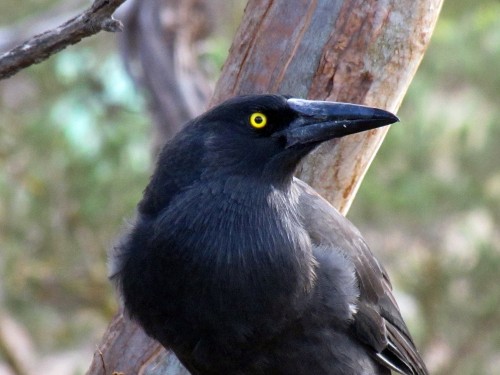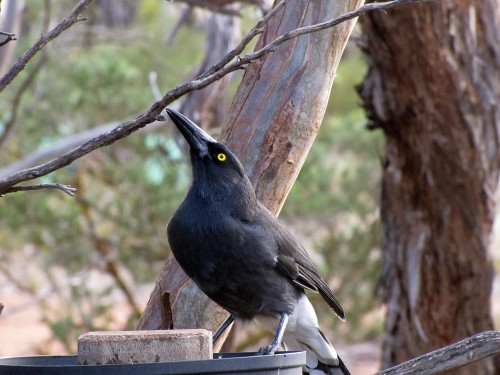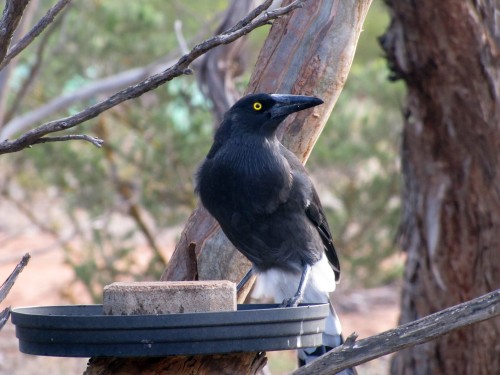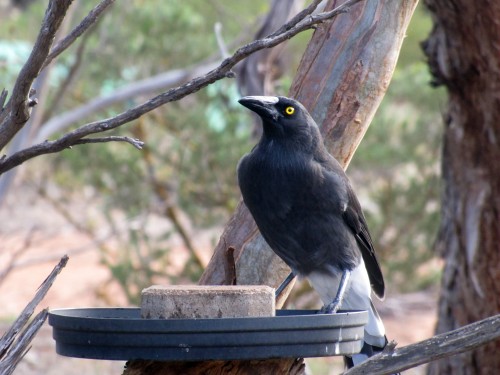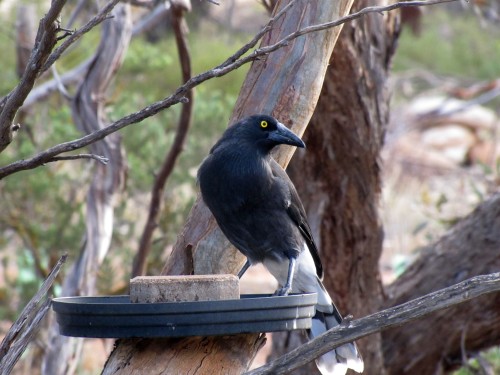Giving an evil eye?
When we bought our home some 30 years ago we never heard or saw Grey Currawongs in our garden or anywhere on our five acre block. They are moderately common and widespread in the district, and this is also true throughout their normal range in southern Australia so it was surprising that we never saw this species in the first decade we lived here.
It appears that several birds moved into the mallee scrub area up the road about a kilometre on a hill overlooking our property. When they called – something which happened only occasionally – we were aware of their presence.
About ten years ago several individuals would occasionally either fly over head, or settle briefly in one of our trees before moving on. This happened every month or so. About five years ago a pair started frequently following their offspring onto our property. These visits occurred every few days.
Now they are relatively regular visitors, even coming to our bird bath on hot days. When they do this it gives me a great opportunity to take a series of photos, like those shown today. These were taken last week during our most recent heat wave.
When you have close up views of this species you suddenly realise how big they are, compared with most of the birds which visit the bird baths. They are much larger than the Australian Magpie-larks, a little larger than Australian Magpies and even the Little Raven. They are certainly much larger than the many honeyeaters which come to drink, and the dainty pardalotes, thornbills and silvereyes are positively minuscule in comparison.
And how about that glaring eye?
Positively gives me a creepy feeling.
Angry birds in our garden
Last week I wrote about the young Grey Currawongs being fed by the adults in our garden. They are still hanging around and squawking noisily whenever they get hungry – which seems to be most of the time.
Yesterday morning I was doing some reading in our sun room when a sudden screeching noise outside interrupted my thoughts. I grabbed the binoculars (but not the camera, alas) and raced outside. High up in the sky above our house a Little Eagle was soaring around on the gentle breeze, obviously looking for something to eat for lunch.
The eagle seemed oblivious to the fact that both currawong parents were attacking it, screeching loudly in order to chase away the offending predator. Slowly, almost nonchalantly, the eagle glided away out of sight and the currawongs calmed down and resumed feeding the young ones., and peace resumed in the garden.
More angry birds
The currawongs are not the only angry birds resident in our garden. The Australian Magpies chase off the Grey Currawongs and the White-winged choughs, the Willie Wagtails are constantly attacking all three already mentioned and the Red Wattlebirds appear to have a distinct dislike towards anything with wings, including the hapless tiny Pardalotes. This latter conflict is a real miss-matched war: wattlebirds are bout 36cm long compared with the pardalotes weighing in at only 8cm. I reckon the wattlebirds are the big bullies in our little patch.
Baby Currawongs in the garden
I had almost finished dressing this morning when my wife called to me from the kitchen. She had just seen a bird she didn’t recognise fly onto the branch of a tree in our garden. I grabbed the camera and headed out to capture said bird on film – well, digitally, anyway.
It turned out to be a very downy young Grey Currawong waiting patiently for the parents to come feed it. Both parents were hovering in the background waiting for me to move back indoors. Later, from a distance, I saw another young bird being fed in trees a little further distance from the house.
Only a few days ago I was wondering why we hadn’t seen any currawongs in our garden recently. They must have been nesting elsewhere and busy feeding these two large babies. Nice to have them around again, though the smaller birds like the honeyeaters detest them, especially when they still have young in the nest. A baby honeyeater, pardalote or thornbill makes a tasty meal for a fast growing currawong.
We have baby Grey Currawongs in the garden
Over recent days we’ve had at least two juvenile Grey Currawongs frequenting our garden. They seem to be independent of the parents and are quite happy to poke around trying to find food for themselves.
I find it a bit odd to call them “babies” as they are as big as the adults already, but are still covered in downy feathers and are not all that confident flying. One recently landed on the gutter of our veranda and I was able to approach to about 2 metres away before it flew off in a clumsy way to the nearest tree. They are still to develop the far reaching piping call of the adults, their call still being a guttural squawk.
A few days ago one ventured too close to some juvenile Willie Wagtails just out of the nest. The Willie Wagtail parents swooped the Currawong mercilessly, banging onto the back of the poor bird until it flew away to a safer spot.
Don’t mess with this currawong
Five years ago we would occasionally hear Grey Currawongs in the distance. They rarely ventured down the hill and into our garden. Over the intervening period, however, their visits to our garden and mallee scrub have become more and more frequent to the point where we both see and hear them almost daily.
Along with this change has come a growing boldness. On several occasions they have visited the bird bath and have visited our back veranda. The bird featured in today’s photo had been wandering around on the veranda and flew off to a nearby fence when I came out to take a photo.
When I downloaded the photo I suddenly became aware of the evil looking yellow eye. Is it sending a message: “Don’t mess with me!”
